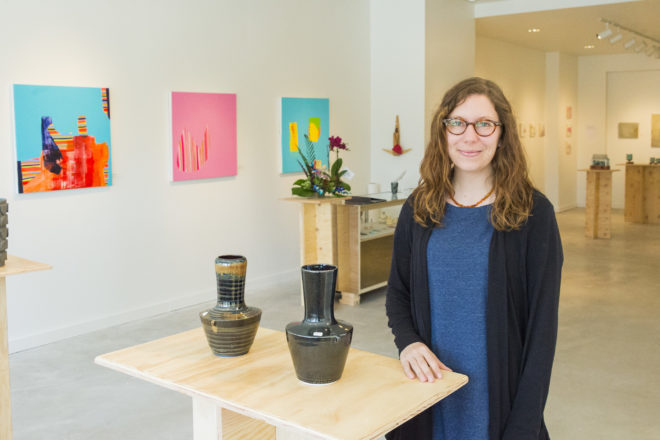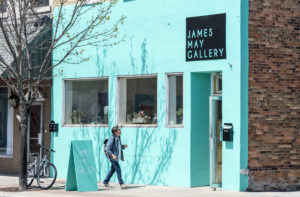How to Get Gallery Representation
- Share
- Tweet
- Pin
- Share

by Kendra Bulgrin, Director, James May Gallery
As I begin thinking about our 2020 calendar and my own experience as a painter and gallerist, I thought it would be helpful to artists to make a “what to do” list.
Approaching a gallery, whether by email or in person, can seem like a daunting task for an emerging artist. Although it is possible to go it alone, a dedicated gallery can support your career. It can free up your time to make art, and it can act as a supporter and sounding board while you develop your work, a public platform for your work and a possible source of income.
What to do when approaching a gallery for an exhibition or representation:
1. Please do not show up unannounced.
This is no longer appropriate and can be extremely off-putting. It catches people off guard, and I know I wouldn’t be able to give you a very detailed critique of your work.

2. Make an appointment if you plan to visit the gallery to show work, or better yet, send an invitation to your studio to show your work in person (see 9).
I have experience as an artist, educator and gallerist. I would be happy to look at your work to give an honest critique (especially for emerging artists who seek feedback). This is my personal protocol as an artist-run gallery director and former educator, but often this is not possible at other galleries.
3. Send professional emails.
I am old school when it comes to sending professional emails. I really appreciate a personal salutation (“Dear x”) and a “Sincerely” or “Thank you” at the end. If you do not address the gallery specifically at the beginning of your email, the recipient will assume you are sending generic emails to every gallery and it just happens to be on your list. Check for punctuation and grammar as well. And personalize! Take the time to look at the gallery’s website and the exhibitions it has had in the past. Mention a favorite artist who has shown work there, or describe how you think you would fit into its programming and vision.
Follow a gallery’s directions if it has a specific way that it accepts work. If it does not accept submissions, do not send one! The ability to follow directions will give the gallery a good idea of what it will be like to work with you and how professional you will be.
4. Include certain elements in your email.
Follow the gallery’s directions if it has a preferred way to review your work. Otherwise, make it as easy as possible for the gallery to review it.
When applying to a gallery, I write an opening paragraph introducing myself and mentioning specifics about the gallery. I also thank the proprietor for his or her time and consideration.
I also include:
• Six to 10 jpgs (72 dpi, no larger than 2 to 3 MB) of current work. Label the images “Lastname_01.”
• Image list corresponding to file titles, including prices
• Artist statement and bio
• Current resume
• Link to your website and/or social media
• Brief proposal (if applicable)
• Full contact details
5. Attend openings.
If you live in the area, try to attend our openings. Introduce yourself and get to know our artists and gallery. It goes a long way when I know you have made an attempt to see our space and attend the openings in support of other artists.
6. Continue to develop your work by attending residencies, maintaining an active studio practice and finding a job that is adjacent to the art world (if possible).
7. Maintain an online presence.
I often discover intriguing artists randomly on IG, stalk them for a while and eventually send them a private message if I really want to work with them. I want to see that an artist maintains a professional website that is up-to-date and easy to navigate.
8. Connect with other artists.
Word-of-mouth and artist connections are important. I often exhibit artists who have been recommended to me by other artists, but showing an unknown artist without any referrals can be risky because we have no idea how the individual will be to work with.
Keep in contact with friends and mentors you met in school, attend residencies where you can meet new artists, participate in group shows, attend openings regularly and try to be social.
9. Open your studio.
Host an open-studio night, and send out invitations by email or postcard (I still love getting artists’ postcards in the mail) to announce it. I also love seeing an artist’s studio and talking about her or his work. It can be difficult to open up such an intimate space to the public, but it can be an important way to further engage your audience. It is a place where visitors can see your process first-hand, where future directions and possibilities can be imagined and where dialogue about your intentions can happen.
10. Speak confidently about your work.
This can not only help you develop rapport with a gallerist, but it can also help to build relationships with possible clients. Learn to speak fluently and self-assuredly about your process and intentions. Be able to discuss where your art falls in the canon and what your historical and contemporary influences are. Be comfortable talking, but do not be overly chatty either: strive for a good back-and-forth conversation.
11. Stay visible and patient.
I have had my fair share of rejections and know first-hand how it can feel. Keep going! Be sure to leave your studio to attend openings, share information with fellow artists and be open to showing your work in any platform.
There are many galleries out there, and it will take time to find a good relationship and fit. Taking the time to develop the right relationship is worth the effort.
Good luck!
This article was originally a blog post from JamesMayGallery.com. Check out the gallery’s website and blog to see more about the gallery’s featured artists.
